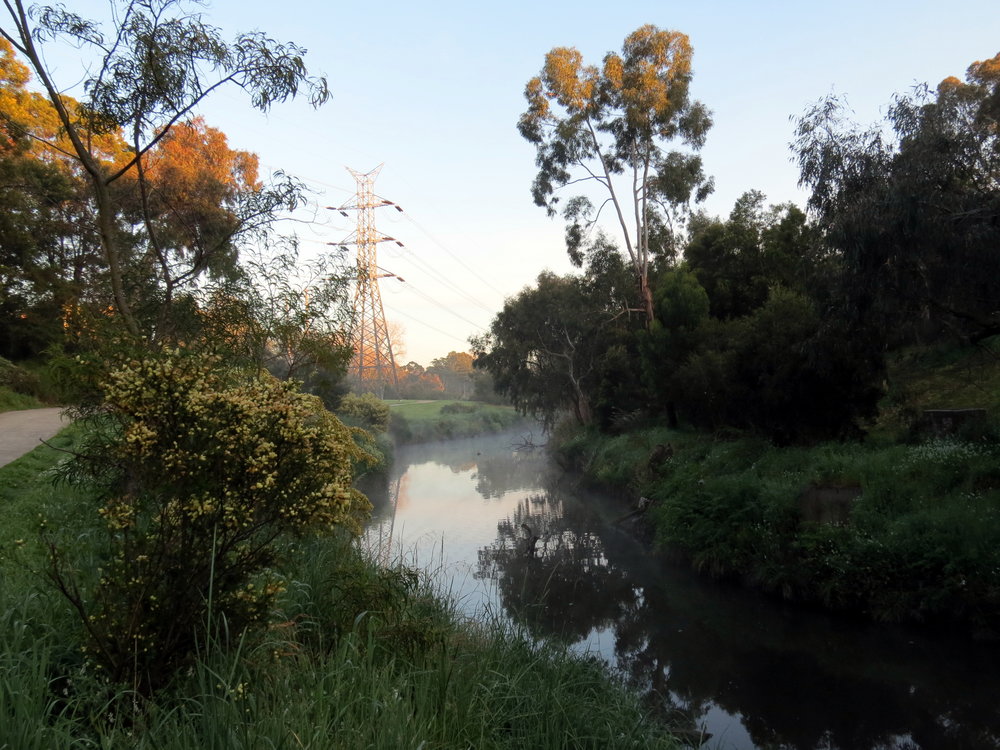The Merri Creek meanders through Melbourne’s north, running from out past Craigieburn through to Dights Falls in Abbotsford where it joins the Yarra. It’s a wildlife hotspot for Melbourne, running through some of the last remnant native grasslands in Melbourne and providing habitat for platypus, echidnas, endangered frogs, and all manner of birds and other critters. Exploring the creek is a joy, with birding sights behind the wonderful CERES Environmental Park, near Dights Falls and out around the Craigieburn and Cooper Street Grasslands.
The grasslands are probably the least well-known sites, with underdeveloped paths and access via industrial neighbourhoods, but they’re a wonderful place to go birding. Nankeen kestrels are regular breeders there, and wedge-tailed and little eagles are often sighted soaring above the grasslands eyeing off the many local rabbits. Flame robins regularly arrive in winter, while spring sees pallid, shining bronze-cuckoos arrive. Grassland birds like Australian pipits, Eurasian skylarks and golden-headed cisticolas are common, as are white-fronted chats and an array of parrots. Interesting rarities turn up too – zebra finches, black-eared cuckoos and Latham’s snipe have all been seen in recent years. There are massive mobs of kangaroos and plenty of swamp wallabies around as well, plus interesting insects, reptiles and amphibians (including the rare growling grass frog).
Things are a bit less diverse around East Brunswick and Northcote, but a wander between Blyth Street and Moreland Road is still likely to turn up a raptor or two – you might see a brown goshawk over the golf course or a peregrine falcon perched above the velodrome – as well as a decent number of bush birds: eastern spinebills, red-browed finches, New Holland honeyeaters and spotted pardalotes are common, while yellow-tailed black cockatoos, crested shrike tits and olive-backed orioles turn up occasionally.


The creek is beloved today, filled with cyclists, joggers and nature lovers but many people don’t realise how lucky we are to still have it. As recounted in Graeme Davidson’s excellent Car Wars, in the mid-1970s the Merri was the prime site for a proposed freeway. If not for a group of passionate and organised locals, the creek would likely be a concreted drain beside a massive road, rather than a pocket of green space winding through the suburbs. In 1976, the threat to the creek prompted the formation of the Merri Creek Management Committee, bringing together local environment activist groups, local councils and scientists. This group has advocated tirelessly for the creek and its catchments, successfully heading off the initial freeway proposal, and later managing to limit the impact of the Western Ring Road extension on the significant Craigieburn Grasslands.
Just as importantly, the MCMC and community groups like the Friends of Merri Creek have coordinated major work in revitalising the creek. They’ve coordinated major projects like the transformation of an old garbage dump into the wonderful CERES Environment Park and the development of the Merri Creek Trail that now runs alongside the creek for more than 20km. They also facilitate lots of hands-on work – removing weeds, planting native vegetation, monitoring water quality and regularly surveying key sites to monitor bird and other wildlife. This work has been a major success, resulting in the return of many species to the creek, including platypus, echidnas and, most famously, sacred kingfishers (whose return to the creek is celebrated annually at CERES).


The Merri Creek is a success story of urban conservation; an example of what happens when motivated and effective community groups can work alongside council and state government. The struggle continues of course, with threats from urban sprawl in particular threatening grassland habitats (the decline of the growling grass frog population is a particularly frustrating example). It’s clear that the work of the Merri Creek Management Committee is more valuable than ever. So come along to a bird survey, get down to a weeding or tree-planting day, or join or donate to the Friends of Merri Creek. It’s a wonderful piece of wild Melbourne, and one that’s worth protecting.
For more information on Merri Creek and the work done to conserve it, follow the links below:
- A history of the revitalisation of the Merri Creek
- Friends of Merri Creek
- Merri Creek Management Committee
Banner image is courtesy of Michael Livingston.


Leave a Reply